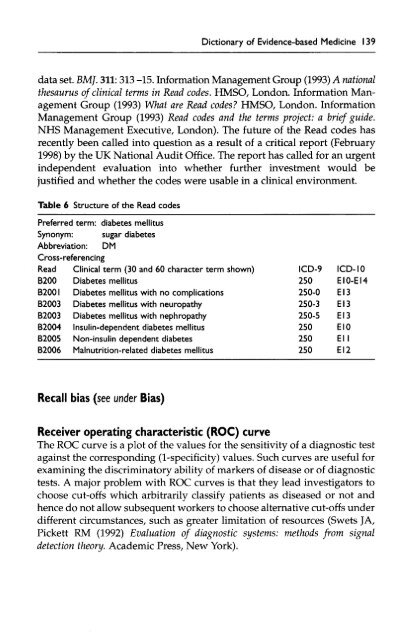Dictionary of Evidence-based Medicine.pdf
Dictionary of Evidence-based Medicine.pdf
Dictionary of Evidence-based Medicine.pdf
Create successful ePaper yourself
Turn your PDF publications into a flip-book with our unique Google optimized e-Paper software.
<strong>Dictionary</strong> <strong>of</strong> <strong>Evidence</strong>-<strong>based</strong> <strong>Medicine</strong> 139<br />
data set. BMJ. 311: 313 -15. Information Management Group (1993) A national<br />
thesaurus <strong>of</strong> clinical terms in Read codes. HMSO, London. Information Management<br />
Group (1993) What are Read codes HMSO, London. Information<br />
Management Group (1993) Read codes and the terms project: a brief guide.<br />
NHS Management Executive, London). The future <strong>of</strong> the Read codes has<br />
recently been called into question as a result <strong>of</strong> a critical report (February<br />
1998) by the UK National Audit Office. The report has called for an urgent<br />
independent evaluation into whether further investment would be<br />
justified and whether the codes were usable in a clinical environment.<br />
Table 6 Structure <strong>of</strong> the Read codes<br />
Preferred term: diabetes mellitus<br />
Synonym: sugar diabetes<br />
Abbreviation: DM<br />
Cross-referencing<br />
Read Clinical term (30 and 60 character term shown)<br />
B200 Diabetes mellitus<br />
B200I Diabetes mellitus with no complications<br />
B2003 Diabetes mellitus with neuropathy<br />
B2003 Diabetes mellitus with nephropathy<br />
B2004 Insulin-dependent diabetes mellitus<br />
B2005 Non-insulin dependent diabetes<br />
B2006 Malnutrition-related diabetes mellitus<br />
ICD-9<br />
250<br />
250-0<br />
250-3<br />
250-5<br />
250<br />
250<br />
250<br />
ICD-IO<br />
EIO-EI4<br />
EI3<br />
EI3<br />
EI3<br />
EIO<br />
Ell<br />
EI2<br />
Recall bias (see under Bias)<br />
Receiver operating characteristic (ROC) curve<br />
The ROC curve is a plot <strong>of</strong> the values for the sensitivity <strong>of</strong> a diagnostic test<br />
against the corresponding (1-specificity) values. Such curves are useful for<br />
examining the discriminatory ability <strong>of</strong> markers <strong>of</strong> disease or <strong>of</strong> diagnostic<br />
tests. A major problem with ROC curves is that they lead investigators to<br />
choose cut-<strong>of</strong>fs which arbitrarily classify patients as diseased or not and<br />
hence do not allow subsequent workers to choose alternative cut-<strong>of</strong>fs under<br />
different circumstances, such as greater limitation <strong>of</strong> resources (Swets JA,<br />
Pickett RM (1992) Evaluation <strong>of</strong> diagnostic systems: methods from signal<br />
detection theory. Academic Press, New York).










